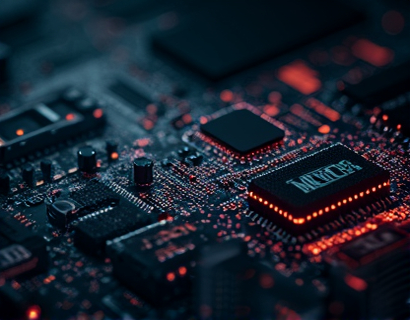Advanced Layer 2 Solutions: Revolutionizing Blockchain Scalability for EVM-Enabled Development
In the rapidly evolving landscape of blockchain technology, scalability remains one of the most critical challenges developers face, especially when working with Ethereum Virtual Machine (EVM)-enabled platforms. The inherent limitations of Layer 1 blockchains, such as limited transaction throughput and high gas fees, have spurred the development of advanced Layer 2 solutions. These solutions aim to enhance scalability, security, and efficiency, thereby unlocking new possibilities for decentralized applications (dApps) and transforming the future of blockchain development.
Layer 2 solutions operate on top of existing blockchain networks, addressing scalability issues without compromising the security and decentralization of the underlying platform. For EVM-based development, these solutions offer a promising pathway to build faster, more secure, and cost-effective dApps. This article delves into the key advanced Layer 2 solutions, their benefits, and how they are revolutionizing EVM-based blockchain development.
Understanding Layer 2 Solutions
Layer 2 solutions are designed to offload some of the computational and transactional burdens from the main blockchain, or Layer 1. By processing transactions off-chain and only settling the final state on-chain, these solutions significantly reduce the load on the primary network. This approach not only increases transaction throughput but also lowers costs and improves latency.
For EVM-enabled blockchains, Layer 2 solutions can be categorized into several types, each with its unique approach to scaling. These include state channels, sidechains, plasma, and rollups. Each type offers distinct advantages and is suited to different use cases, providing developers with a range of options to optimize their blockchain applications.
State Channels
State channels, also known as payment channels, allow two or more parties to conduct multiple transactions off-chain, with only the final state being recorded on the blockchain. This method is particularly effective for applications that involve frequent, small transactions, such as micropayments or peer-to-peer payments.
The process begins with an initial deposit of funds into a smart contract on the main blockchain. The parties then engage in a series of off-chain transactions, updating a shared state that is only settled on the blockchain when the channel is closed. This approach drastically reduces the number of on-chain transactions, leading to lower fees and faster processing times.
For EVM-based development, state channels can be implemented using custom smart contracts that manage the channel state and ensure security through cryptographic proofs. This method is ideal for applications like gaming, where frequent transactions are common and latency is a critical factor.
Sidechains
Sidechains are independent blockchains that are linked to the main blockchain through a two-way peg. They allow assets to be transferred between the main chain and the sidechain, enabling more flexible and scalable transaction processing. Sidechains can operate with different consensus mechanisms and rules, providing greater customization for specific use cases.
In the context of EVM-based development, sidechains can be used to offload certain types of transactions or smart contract executions, freeing up resources on the main chain. This approach not only enhances scalability but also allows developers to experiment with new features and protocols without impacting the primary network.
One of the key benefits of sidechains is their ability to support different programming languages and development frameworks, making them a versatile solution for diverse blockchain applications. However, the security of sidechains relies on the integrity of the two-way peg, which must be robustly implemented to prevent vulnerabilities.
Plasma
Plasma is a scalability framework that uses a tree-like structure to batch and settle transactions off-chain, with only the final results submitted to the main blockchain. This approach significantly reduces the number of transactions that need to be processed on the main chain, leading to higher throughput and lower fees.
In a Plasma setup, child chains or "branches" are created from the main chain, where multiple transactions can be processed in parallel. Each branch maintains its own state, which is periodically snapshotted and submitted to the main chain. This snapshotting mechanism ensures that the main chain only needs to verify the final state, rather than each individual transaction.
For EVM-based development, Plasma offers a scalable solution for building complex dApps that require high transaction volumes. However, the complexity of the Plasma architecture and the need for careful state management can pose challenges for developers. Ensuring the security and correctness of the snapshotting process is crucial to maintaining the integrity of the system.
Rollups
Rollups are one of the most promising Layer 2 solutions for EVM-based blockchains, offering high scalability and security while maintaining the decentralization of the underlying network. There are two main types of rollups: Optimistic Rollups and ZK Rollups.
Optimistic Rollups bundle multiple transactions into a single transaction on the main chain, assuming they are valid. If any transaction is found to be invalid, a fraud proof can be submitted to reverse the batch. This approach significantly reduces the number of on-chain transactions, leading to lower fees and faster processing times.
ZK Rollups, on the other hand, use zero-knowledge proofs to bundle and verify transactions off-chain, submitting only the compressed proof to the main chain. This method provides stronger security guarantees and higher throughput, as the main chain only needs to verify the proof rather than each individual transaction.
For EVM-based development, rollups offer a powerful solution for building scalable and efficient dApps. The Ethereum 2.0 upgrade includes a native rollup implementation, which will further enhance the scalability and interoperability of the Ethereum ecosystem. Developers can leverage these rollups to create high-performance applications without compromising on security or decentralization.
Benefits of Advanced Layer 2 Solutions
The adoption of advanced Layer 2 solutions brings numerous benefits to EVM-based blockchain development. Firstly, scalability is significantly improved, allowing for higher transaction throughput and reduced congestion on the main chain. This leads to faster transaction confirmations and a smoother user experience for dApp users.
Secondly, cost efficiency is a major advantage. By reducing the number of on-chain transactions, Layer 2 solutions lower gas fees, making blockchain applications more accessible and affordable. This is particularly important for microtransactions and high-volume use cases, where traditional on-chain processing would be prohibitively expensive.
Security is another critical aspect where Layer 2 solutions excel. Advanced cryptographic techniques and robust validation mechanisms ensure that off-chain transactions are secure and tamper-proof. For EVM-based development, this means that developers can build trustworthy dApps without sacrificing the security of the underlying blockchain.
Lastly, the flexibility and customization offered by Layer 2 solutions enable developers to tailor their blockchain applications to specific use cases. Whether it's through state channels, sidechains, Plasma, or rollups, developers have the tools to optimize their dApps for performance, cost, and security.
Challenges and Considerations
While advanced Layer 2 solutions offer significant advantages, there are also challenges and considerations that developers must address. One of the primary concerns is the complexity of implementing and integrating these solutions into existing EVM-based projects. Developers need to have a solid understanding of the underlying mechanics and potential pitfalls to ensure a smooth deployment.
Interoperability between different Layer 2 solutions and the main blockchain is another critical factor. Ensuring seamless communication and asset transfer between Layer 1 and Layer 2 layers requires well-designed protocols and standards. Developers should consider the ecosystem's compatibility and future-proofing when choosing a Layer 2 solution.
Additionally, the governance and maintenance of Layer 2 systems are essential for long-term sustainability. Developers must be involved in the governance processes to ensure that updates and improvements are made in a decentralized and transparent manner. This helps maintain the trust and reliability of the Layer 2 solutions.
Unlocking the Next Generation of Decentralized Applications
The integration of advanced Layer 2 solutions into EVM-based blockchain development marks a significant step towards realizing the full potential of decentralized applications. By addressing scalability, security, and cost efficiency, these solutions pave the way for more innovative and user-friendly dApps.
Developers who embrace these advanced Layer 2 solutions can create next-generation applications that were previously unfeasible on traditional blockchain platforms. From decentralized finance (DeFi) protocols to non-fungible token (NFT) marketplaces, the possibilities are vast and exciting.
As the blockchain ecosystem continues to evolve, the role of Layer 2 solutions will become increasingly prominent. By staying informed and leveraging these technologies, developers can stay ahead of the curve and contribute to the growth and adoption of blockchain-based solutions.










































